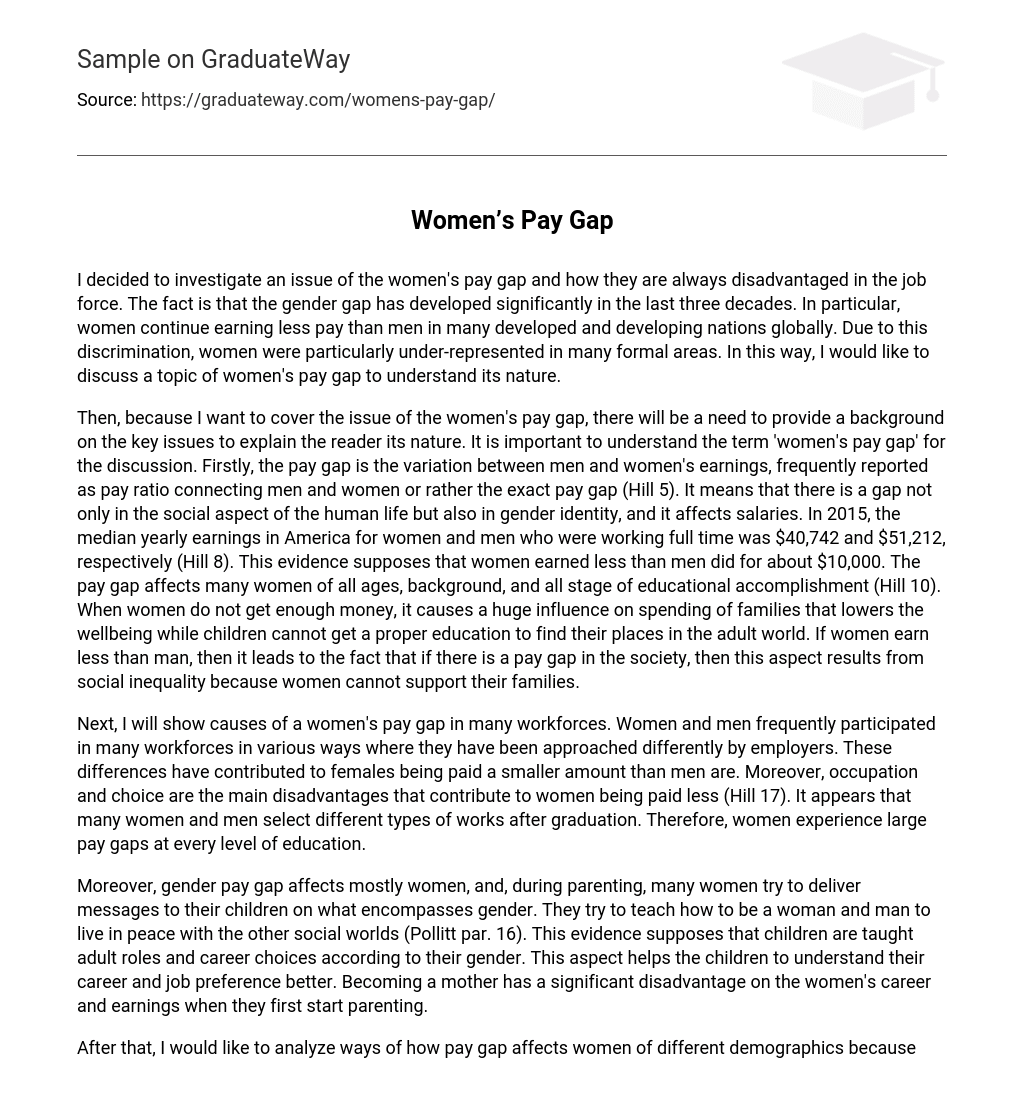I decided to investigate an issue of the women’s pay gap and how they are always disadvantaged in the job force. The fact is that the gender gap has developed significantly in the last three decades. In particular, women continue earning less pay than men in many developed and developing nations globally. Due to this discrimination, women were particularly under-represented in many formal areas. In this way, I would like to discuss a topic of women’s pay gap to understand its nature.
Then, because I want to cover the issue of the women’s pay gap, there will be a need to provide a background on the key issues to explain the reader its nature. It is important to understand the term ‘women’s pay gap’ for the discussion. Firstly, the pay gap is the variation between men and women’s earnings, frequently reported as pay ratio connecting men and women or rather the exact pay gap (Hill 5). It means that there is a gap not only in the social aspect of the human life but also in gender identity, and it affects salaries. In 2015, the median yearly earnings in America for women and men who were working full time was $40,742 and $51,212, respectively (Hill 8). This evidence supposes that women earned less than men did for about $10,000. The pay gap affects many women of all ages, background, and all stage of educational accomplishment (Hill 10). When women do not get enough money, it causes a huge influence on spending of families that lowers the wellbeing while children cannot get a proper education to find their places in the adult world. If women earn less than man, then it leads to the fact that if there is a pay gap in the society, then this aspect results from social inequality because women cannot support their families.
Next, I will show causes of a women’s pay gap in many workforces. Women and men frequently participated in many workforces in various ways where they have been approached differently by employers. These differences have contributed to females being paid a smaller amount than men are. Moreover, occupation and choice are the main disadvantages that contribute to women being paid less (Hill 17). It appears that many women and men select different types of works after graduation. Therefore, women experience large pay gaps at every level of education.
Moreover, gender pay gap affects mostly women, and, during parenting, many women try to deliver messages to their children on what encompasses gender. They try to teach how to be a woman and man to live in peace with the other social worlds (Pollitt par. 16). This evidence supposes that children are taught adult roles and career choices according to their gender. This aspect helps the children to understand their career and job preference better. Becoming a mother has a significant disadvantage on the women’s career and earnings when they first start parenting.
After that, I would like to analyze ways of how pay gap affects women of different demographics because some people are sure that women have similar salaries to make a counterargument. For example, African American, American Indian, and other Pacific Islander women and men get higher salaries during their life and career growth (Hill 11). It means that the difference is larger notably among the older women in the comparison to the younger persons, and people can care about their children and families. Unfortunately, since women of different demographics and ages have improvements in salaries in the comparison to the past, they still do not get enough money to deal with the external world. In simple words, even demographics and ages did not improve salaries of women during the years. Therefore, my counterargument that women have enough money during their career growth and life is not valid because men also get salaries that are higher while they do not need to spend their time on pregnancy and education of children.
Considering the various issues that affect women’s pay gap, I conclude that the pay gap is the difference between men and women pay’s earnings that mutually depend on different ages and education of an individual. These variations have contributed to women being paid less compared to men in many workforces. Thus, during parenting children are taught gender roles and career choices. However, women of different demographics and ages still suffer because of inappropriate salaries in the case of the modern living standards, and they cannot teach their children how to become a proper member of the society in the adult life. As for my working thesis statement, I would like to state that woman of different demographics and ages still face a pay gap that causes a negative influence on the society because children cannot get a proper education, learn their gender roles, and make career choices correctly even if their salaries are increased.





